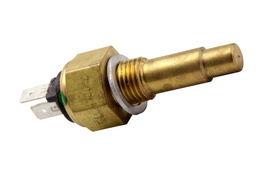
Oxygen sensor is that part of the car, which feeds and controls data to the computer system that works in line with the engine of the car. The main aim of using and installing an oxygen sensor at the first place is to make sure that your engine runs efficiently but emits as less as possible. These sensors are very beneficial since exhaust emissions are posing a big challenge to the entire world. The sensors are located at the exhaust pipe and it has the capability to differentiate between rich and lean mixtures. Rich and lean mixtures refer to the ratio of gasoline and air. There is something called a “perfect” mixture, the ratio of which is 14.7:1. If the proportion of air is lesser than the proportion of gasoline then that mixture is called a “rich mixture” and if there is more air the mixture is called “lean mixture”. Now the rich mixtures are bad because in this case, the unburned fuel works like a pollutant. The functioning of a sensor is very simple. It involves a chemical reaction that generates a voltage that is recorded by the computer. Now if the mixture is lean or rich, depending on it, the computer will determine the volume of fuel that should enter the engine. So this is how the oxygen sensor helps the engine in controlling the emissions as the amount of energy that the engine can pull is dependent on a lot of things like altitude, the temperature of the air, engine temperature, barometric pressure, load on the engine and the like. If the oxygen sensor fails, the car starts performing poorly and you end up spending more fuel and money.
Common Problems
Oxygen Sensor problems are very simple and common. As and when the sensor becomes older, the pollutants and the contaminants from the normal combustion and oil ash start accumulating on the element that senses the amount of oxygen. Thus it reduces the sensor’s ability to perform and respond quickly to changes in the air or fuel mixture. The sensor becomes slow and starts performing sluggishly. The other problem that might occur is that the output voltage of the sensor, which might not remain as high as, it was previously, thus it might give is an impression that the air-fuel mixture is leaner than it actually is, as a result of which the computer would keep sending fuel to the engine thus resulting in a far richer air-fuel mixture. This defeats the whole point of getting an oxygen sensor installed.
The problems in the sensor might not be felt at the earlier stage since it happens gradually but then as times passes the problem would get worse and worst. Ultimately the engine is damaged or the sensor has to be replaced to get the engine to perform efficiently. If you know that it is still not time for the oxygen sensor to show problems and it is doing so prematurely then it is time for you to be cautious. If the sensor becomes contaminated more than it normally should be, it can be due to leaded gasoline, phosphorous from excessive oil consumption or silicone form internal coolant leaks or due to using silicone sprays or gasket sealers on the engine. Road Splash, salt, oil and dirt are some of the environmental factors that can also damage the sensor. It can also be affected by mishandling or mechanical stress as well. Sensors can also be damages due to the catalytic converter in the car. When the operating condition is “rich”, the converter becomes hot, if the converter becomes hot enough to melt the catalyst then the molten catalyst might lead to partial or complete blockage inside it. This might in turn lead to a considerable drop in highway performance or arrest of motion due to formation of backpressure in the exhaust system. In some cars there is a light to remind you that it is time to check and change your oxygen sensor, so do not ignore that reminder and wait for your car to show symptoms.
I am sure this article would give you relevant information on oxygen sensors and help you to understand their functioning better.